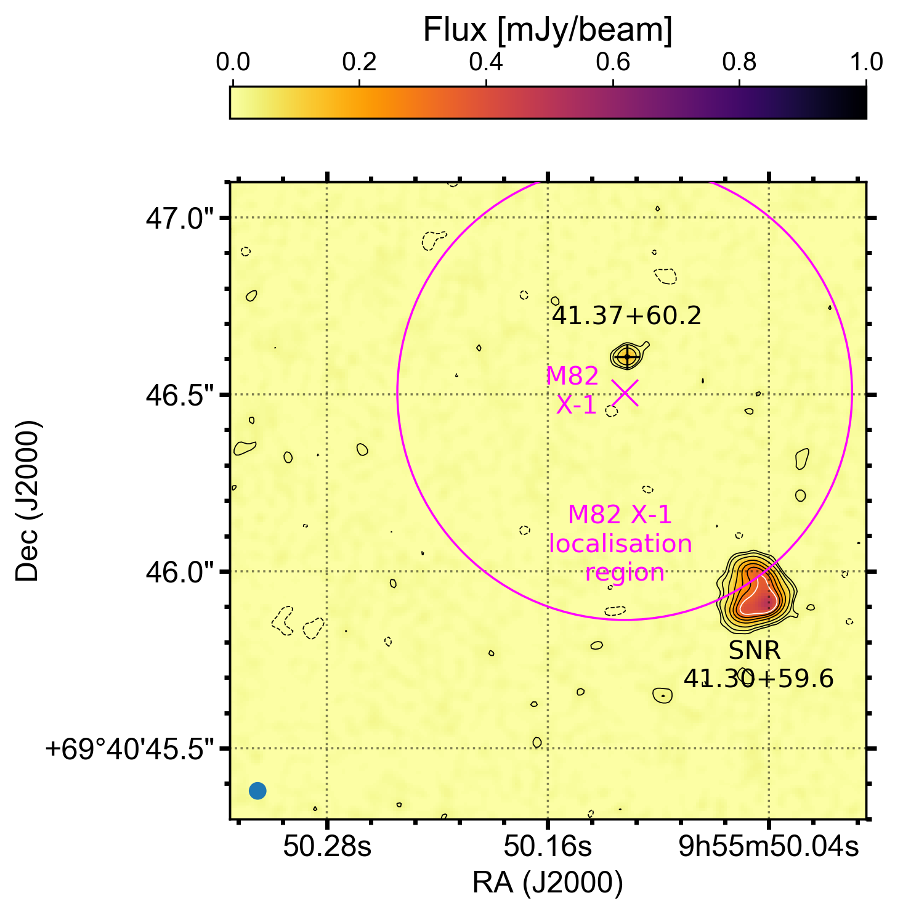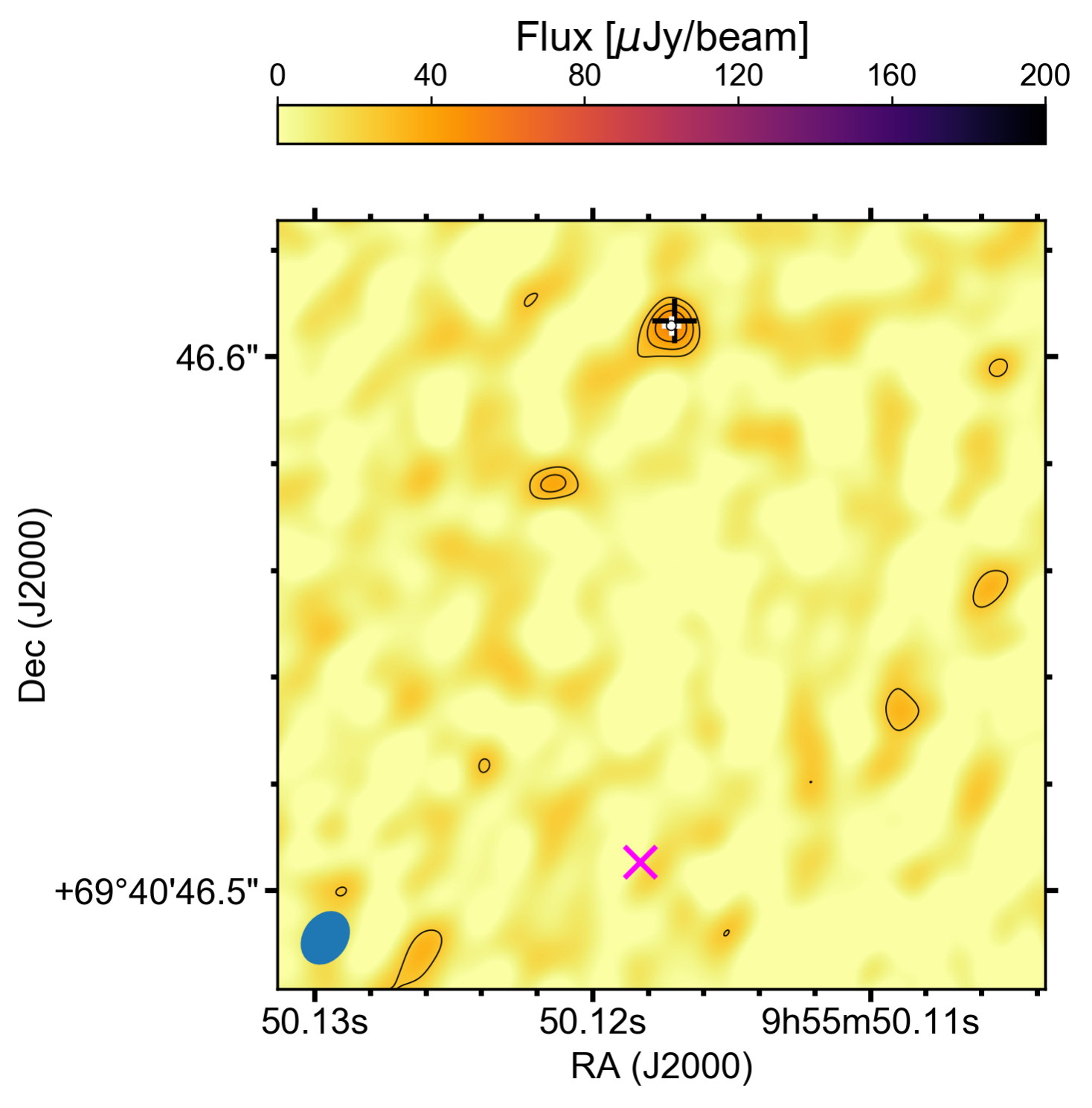
Radio emission from the intermediate mass black hole candidate M82 X-1 using e-MERLIN and the EVN.
David Williams-Baldwin
The nearby starburst galaxy M82 has been regularly monitored by high resolution radio interferometers over the last 40 years (e.g. Kronberg and Sramek 1985, Muxlow et al. 1994, Kording et al. 2005, Fenech et al. 2010), enabling the detection of a population of ultra-compact HII regions, many SNRs, and in some cases `exotic’ radio variables and transients that have been attributed to the supernova SN2008iz (e.g., Brunthaler et al. 2009), microquasars (e.g. Kronberg and Sramek 1985, Muxlow et al. 2010, Joseph et al. 2011) and gamma ray burst afterglows (Muxlow et al. 2005). However, in all this time, no radio source has been unequivocally associated with the brightest ultra-luminous X-ray source (ULX) in M82, M82 X-1.
M82 X-1 is considered to be one of the best intermediate-mass black hole (IMBH) candidates due to its X-ray timing properties (e.g. Pasham et al. 2014). Various methods have suggested it has a black hole mass of 20-1000 solar masses (see Mondal et al. 2022 and references there-in). ULXs - off-nuclear compact X-ray sources with X-ray luminosity larger than 1039 erg/s - are thought to be a mixed population powered by IMBHs or in some cases, neutron stars (e.g., Bachetti et al. 2014). Much of the ULX population could be powered by neutron stars, but if star formation is properly considered, then it is unlikely that the ULX is powered by a neutron star and likely to be an IMBH (Panurach et al. 2024). Therefore, regular monitoring is required to detect the expected faint radio flares from IMBH candidate systems.
Using archival e-MERLIN data and EVN+e-MERLIN data obtained over the last decade, we have made the first detections of M82 X-1 in the radio band. The e-MERLIN image is the most sensitive 50 mas-scale image of M82 to-date (r.m.s. sensitivity 7𝜇Jy/beam), detecting a new radio source co-incident with the best X-ray position of M82 X-1 (Xu et al. 2015) at more than 20 sigma (151±10 𝜇Jy/beam). Follow-up e-MERLIN observations in 2016 did not detect the source, but an EVN+e-MERLIN observation obtained in 2021 also detected a spatially consistent radio source with M82 X-1 with a flux density of 53±10 𝜇Jy/beam. The 2015/2016 data tentatively correlates with the X-ray fluxes (Brightman et al. 2020) obtained in this time period, suggesting periods of activity in the radio may be related to the X-ray variability. The repeated high-resolution images obtained with the EVN and e-MERLIN interferometers has enabled the detection of this important IMBH candidate for the first time and resolved the source from the nearby SNR 41.30+59.6.

Figure 1. Deep (r.m.s. sensitivity = 7𝜇Jy/beam) e-MERLIN 5-6 GHz radio image of the region close to intermediate-mass black hole candidate M82 X-1. The background radio map shows a supernova remnant (SNR 41.30+59.6) to the south-west of the new radio source, 41.37+60.2. This new source, also detected by the EVN (black plus symbol) is spatially co-incident with the X-ray position of M82 X-1 (Xu et al. 2015), shown as the magenta cross and magenta 3 sigma localisation region. The black contours shown are -3, 3, 5, 10, 20, 30, 40 × 7𝜇Jy/beam. A single white contour at 350𝜇Jy/beam is also shown for the SNR 41.30+59.6.

Figure 2. EVN+e-MERLIN radio image of the region close to M82 X-1. The position of the new e-MERLIN (black plus symbol) and EVN+e-MERLIN (white `plus’ symbol) source, 41.37+60.2, agrees to within 100 mas of the astrometry corrected position of M82 X-1 (magenta cross). As the astrometric corrections are almost entirely in declination, and the accuracy of the astrometric correction is ~100 mas, the radio source is consistent with the X-ray source.
Link to the paper:
Contact:
David Williams-Baldwin, e-MERLIN Operations Support Scientist, Jodrell Bank Observatory, University of Manchester. Email: david.williams-7@manchester.ac.uk